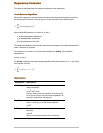
Appendix B: Technical Reference 943
Parentheses, Brackets, and Braces
Parentheses, Brackets, and BracesParentheses, Brackets, and Braces
Parentheses, Brackets, and Braces
All calculations inside a pair of parentheses, brackets, or braces are evaluated first. For
example, in the expression 4(1+2), EOS first evaluates the portion of the expression
inside the parentheses, 1+2, and then multiplies the result, 3, by 4.
The number of opening and closing parentheses, brackets, and braces must be the
same within an expression or equation. If not, an error message is displayed that
indicates the missing element. For example, (1+2)/(3+4 will display the error message
“Missing ).”
Note: Because the TI-89 Titanium / Voyage™ 200 allows you to define your own
functions, a variable name followed by an expression in parentheses is considered a
“function call” instead of implied multiplication. For example a(b+c) is the function a
evaluated by b+c. To multiply the expression b+c by the variable a, use explicit
multiplication: aù(b+c).
Indirection
IndirectionIndirection
Indirection
The indirection operator (#) converts a string to a variable or function name. For
example, #(“x”&”y”&”z”) creates the variable name xyz. Indirection also allows the
creation and modification of variables from inside a program. For example, if 10
&r and
“r”
&s1, then #s1=10.
Post Operators
Post OperatorsPost Operators
Post Operators
Post operators are operators that come directly after an argument, such as 5!, 25%, or
60
ó15' 45". Arguments followed by a post operator are evaluated at the fourth priority
level. For example, in the expression 4^3!, 3! is evaluated first. The result, 6, then
becomes the exponent of 4 to yield 4096.
Exponentiation
ExponentiationExponentiation
Exponentiation
Exponentiation (^) and element-by-element exponentiation (.^) are evaluated from right
to left. For example, the expression 2^3^2 is evaluated the same as 2^(3^2) to produce
512. This is different from (2^3)^2, which is 64.
Negation
NegationNegation
Negation
To enter a negative number, press
· followed by the number. Post operations and
exponentiation are performed before negation. For example, the result of
ëx
2
is a
negative number, and
ë9
2
=ë81. Use parentheses to square a negative number such as
(
ë9)
2
to produce 81. Note also that negative 5 (ë5) is different from minus 5 (ì5), and ë3!
evaluates as
ë(3!).
Constraint (|)
Constraint (|)Constraint (|)
Constraint (|)
The argument following the “with” (|) operator provides a set of constraints that affect the
evaluation of the argument preceding the “with” operator.
14 Constraint “with” operator (|)
15 Store (!)


















